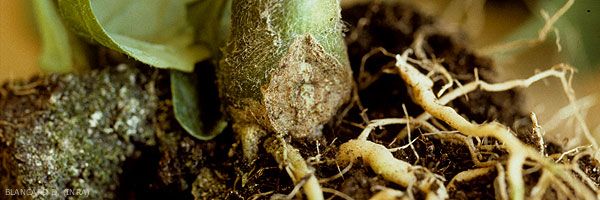
Corky collar and pivot
A corky and basal deterioration of the tomato stem ( corky corky , crown and taproot crown ) is sometimes observed in some crops. These symptoms and their development are reminiscent of those already described in other nightshades, such as pepper (basal necrosis of pepper) and tobacco (corky neck of tobacco), but the origin of the problem remains poorly understood. Among the alterations, we note in particular:
- a slight chlorosis and a reversible wilting of the plants at the hottest periods of the day, a slowing down of their growth;
- suberization and necrosis of the neck (the diameter of which is sometimes greater) and of the pivot which undergo more or less significant bursts (figure 1). The latter are in part due to the loss of elasticity of the tissues of the cortex which, after suberization, have more difficulty in adjusting to the enlargement of the rod. Note that these bursts sometimes allow opportunistic microorganisms to proliferate and lead to the browning of deep tissues and the most superficial vessels. The weakening of the collar can also lead to lodging of the plants;
- the taproot may show narrowing, the secondary roots are necrotic and slightly suberized.
As with other Solanaceae, the origin of this disease does not appear to be parasitic. It could be linked to repeated micro-asphyxia occurring quite early in the nursery and after planting, at the origin of superficial alterations which would induce in the plants the development, at the level of the submerged parts, of corky scar tissue. Its expression would be favored by the implementation of cultivation practices at the origin of water stagnation. Excess salinity could also promote the onset of symptoms.
Likewise, it should be noted that crown rots have been observed in hydroponic (NFT) tomato crops in Great Britain, due to the accumulation and crystallization of soluble salts (nitrogen and phosphates) near the neck of the tomatoes. plants. The presence of an excess of salts at the level of the lower part of the stem initially induced tissue burns, then a constriction of the neck and a reduction in the flow of water. Plant wilting ensued. Note that the tomato appears to be more sensitive to excess salts in the soil than in the soil. In the latter case, the development of its root system is slower.
- a slight chlorosis and a reversible wilting of the plants at the hottest periods of the day, a slowing down of their growth;
- suberization and necrosis of the neck (the diameter of which is sometimes greater) and of the pivot which undergo more or less significant bursts (figure 1). The latter are in part due to the loss of elasticity of the tissues of the cortex which, after suberization, have more difficulty in adjusting to the enlargement of the rod. Note that these bursts sometimes allow opportunistic microorganisms to proliferate and lead to the browning of deep tissues and the most superficial vessels. The weakening of the collar can also lead to lodging of the plants;
- the taproot may show narrowing, the secondary roots are necrotic and slightly suberized.
As with other Solanaceae, the origin of this disease does not appear to be parasitic. It could be linked to repeated micro-asphyxia occurring quite early in the nursery and after planting, at the origin of superficial alterations which would induce in the plants the development, at the level of the submerged parts, of corky scar tissue. Its expression would be favored by the implementation of cultivation practices at the origin of water stagnation. Excess salinity could also promote the onset of symptoms.
Likewise, it should be noted that crown rots have been observed in hydroponic (NFT) tomato crops in Great Britain, due to the accumulation and crystallization of soluble salts (nitrogen and phosphates) near the neck of the tomatoes. plants. The presence of an excess of salts at the level of the lower part of the stem initially induced tissue burns, then a constriction of the neck and a reduction in the flow of water. Plant wilting ensued. Note that the tomato appears to be more sensitive to excess salts in the soil than in the soil. In the latter case, the development of its root system is slower.





